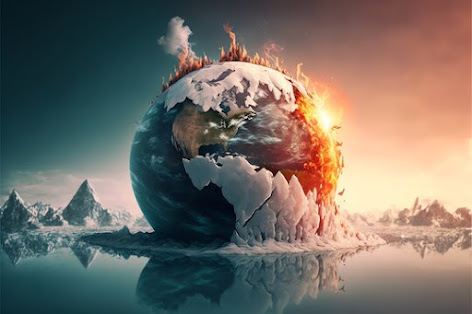Global warming is a critical environmental issue caused primarily by the increase in greenhouse gas emissions from human activities. Here are some interesting facts about global warming
Critical Environmental Issue Caused Primarily Here Are Some Interesting Facts About Global Warming
Greenhouse Effect: Global warming is driven by the enhanced greenhouse effect, which occurs when certain gases in the Earth's atmosphere trap heat from the sun, leading to an increase in the planet's average temperature.
Carbon Dioxide (CO2): Carbon dioxide is the primary greenhouse gas responsible for global warming. Burning fossil fuels such as coal, oil, and natural gas releases CO2 into the atmosphere, contributing to the problem.
Historical Trends: Global temperatures have been on the rise since the late 19th century. The last few decades have witnessed particularly rapid warming, with 20 of the hottest years on record occurring since 2001.
Melting Ice: Rising temperatures have caused glaciers and polar ice caps to melt at an accelerated rate. This contributes to rising sea levels, which can lead to coastal erosion and increased flooding.
Sea Level Rise: The melting ice, along with the thermal expansion of seawater as it warms, has led to a global sea level rise of about 8-9 inches (20-23 centimeters) since the early 20th century. Projections indicate that sea levels could rise significantly more in the coming century, threatening coastal communities.
Extreme Weather: Global warming is associated with an increase in extreme weather events, such as hurricanes, heatwaves, droughts, and heavy rainfall. These events can have devastating impacts on ecosystems, economies, and human health.
Ocean Acidification: The absorption of excess CO2 by the world's oceans has led to ocean acidification. This harms marine life, particularly organisms with calcium carbonate shells and skeletons, like corals and some shellfish.
Climate Refugees: Rising sea levels and changing weather patterns are expected to displace millions of people from their homes, creating a new category of refugees known as climate refugees.
Positive Feedback Loops: Global warming can trigger positive feedback loops that amplify the problem. For example, as Arctic ice melts, it reduces the Earth's reflectivity, causing more heat absorption and further warming.
Mitigation Efforts: Various efforts are underway to combat global warming, including the Paris Agreement, which aims to limit global temperature increases to well below 2 degrees Celsius above pre-industrial levels.
Renewable Energy: Transitioning to renewable energy sources like solar, wind, and hydroelectric power is a critical step in reducing greenhouse gas emissions and mitigating global warming.
Individual Actions: Reducing one's carbon footprint through actions like energy conservation, reducing meat consumption, and using public transportation can also make a positive impact on the climate.
Climate Activism: Young activists, such as Greta Thunberg, have gained international recognition for their efforts to raise awareness about climate change and advocate for government action.
Technological Innovations: Advancements in technology, such as carbon capture and storage, are being explored to capture and reduce greenhouse gas emissions from various sources.
Global Impact: Global warming affects not only the environment but also economies, agriculture, food security, and public health. Addressing this issue requires international cooperation and collective action.
These facts highlight the complex and urgent nature of the global warming problem and the need for concerted efforts to mitigate its impacts.






0 Comments